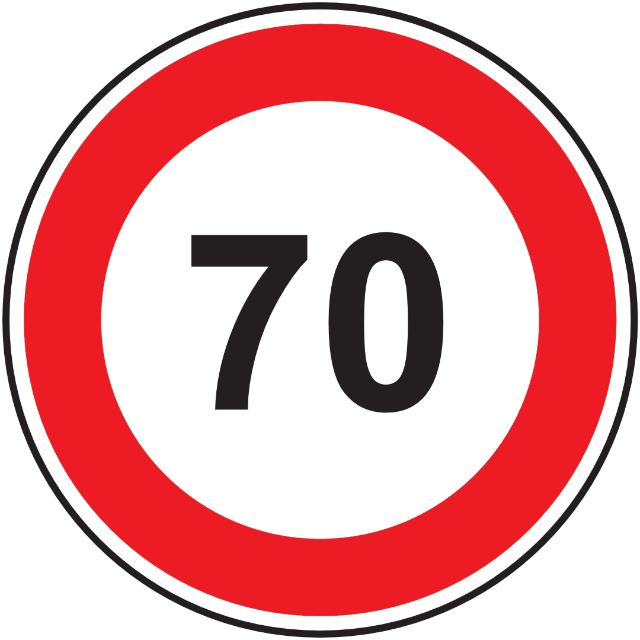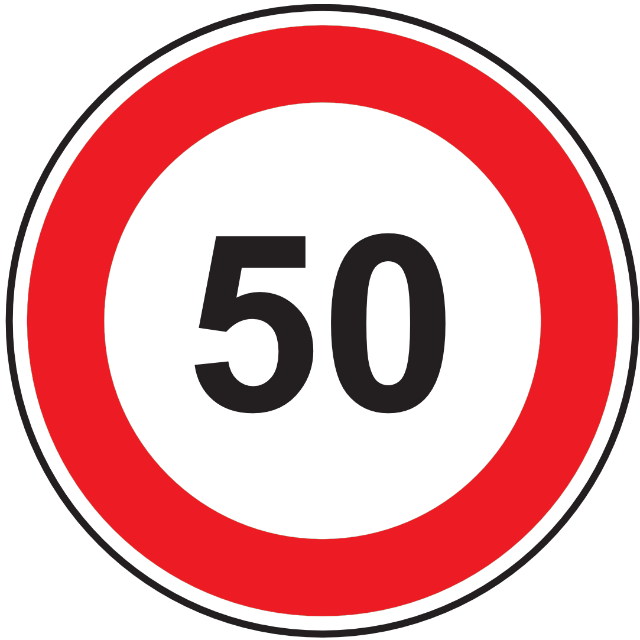Which rule are you interested in?
- Seat belts
- Traffic lights
- Speed limits
- Alcohol limits
- Influence of drugs
- Forbidden lane
- Safety helmet
- Mobile telephone
- Other specific rules
The use of seat belts and child restraint systems is MANDATORY (Directive 91/671/EEC as amended). Seats belts are not compulsory for:
Child seats are not compulsory for:
|
|
Motorcycles
Vehicles below 3.5 t
Standard speed limits (unless otherwise stated by traffic signs) [km/h]
 | Urban areas: 50 km/h in Flanders and Wallonia, and 30 km/h in Brussels. |
 | 20 km/h in residential areas. |
  | 30 km/h near schools and in bicycle priority lanes (“rue cyclable”/ “fietsstraat”). |
 | Outside urban areas in Wallonia and Brussels On public roads with two or more lanes in each direction, separated by road markings, and on the other public roads. |
 | Outside urban areas in the Flemish Region On public roads with two or more lanes in each direction, separated by road markings, and on the other public roads. |
 | Motorways and roads with two or more lanes in each direction, not separated by road markings. |
Passenger cars & vans
Vehicles below 3.5 t
Standard speed limits (unless otherwise stated by traffic signs) [km/h]
 | Urban roads |
 | 20 km/h in residential areas. |
 | 30 km/h near schools and in streets with cycle paths |
 | Outside built-up areas Public roads with two or more lanes in each direction, separated by road markings; and other public roads. |
 | Outside built-up areas in the Flemish Region Public roads with two or more lanes in each direction, separated by road markings; and other public roads. |
 | Motorways and roads with two or more lanes in each direction, not separated by road markings. |
Passenger cars & vans with trailers
Vehicles below 3.5 t
Standard speed limits (unless otherwise stated by traffic signs) [km/h]
 | Urban roads |
 | 20 km/h in residential areas. |
 | Outside built-up areas Public roads with two or more lanes in each direction, separated by road markings; and other public roads. |
 | Outside built-up areas in the Flemish Region Public roads with two or more lanes in each direction, separated by road markings; and other public roads. |
 | 30 km/h near schools and in streets with cycle paths |
 | Motorways and roads with two or more lanes in each direction, not separated by road markings. |
Heavy-duty motor vehicles
over 3.5 t
Standard speed limits (unless otherwise stated by traffic signs) [km/h]
 | Urban areas: 50 km/h in Flanders and Wallonia, and 30 km/h in Brussels. |
 | 20 km/h in residential areas. |
  | 30 km/h near schools and in bicycle priority lanes (“rue cyclable”/ “fietsstraat”). |
 | Outside urban areas in Wallonia and Brussels On public roads with two or more lanes in each direction, separated by road markings, and on the other public roads. ! For heavy-duty motor vehicles over 7,5 t, the speed limit is 60 km/h on the other public roads. |
 | Outside urban areas in the Flemish Region On public roads with two or more lanes in each direction, separated by road markings, and on the other public roads. ! For heavy-duty motor vehicles over 7,5 t, the speed limit is 60 km/h on the other public roads. |
 | Motorways and roads with two or more lanes in each direction, not separated by road markings. |
Buses
Standard speed limits (unless otherwise stated by traffic signs) [km/h]
 | Urban areas: 50 km/h in Flanders and Wallonia, and 30 km/h in Brussels. |
  | 30 km/h near schools and in bicycle priority lanes (“rue cyclable”/ “fietsstraat”). |
 | 20 km/h in residential areas. |
 | On motorways, on roads with two or more lanes in both directions in Wallonia and in the Brussels-Capital Region, and on roads with two or more lanes in both directions separated other than by road markings in the Flemish Region. |
 | Outside urban areas in Wallonia and Brussels: on the other public roads. |
 | Outside urban areas in the Flemish Region On public roads with two or more lanes in each direction, separated by road markings, and on the other public roads. |
 | For buses and coaches equipped with seat belts and a speed limiter set to a maximum speed of 100 km/h on motorways. |
| 0.5 g/l Standard drivers | |
| 0.5 g/l Novice drivers | |
| 0.2 g/l Professional drivers |
Forbidden drugsTHC (cannabis) (≥1 ng/ml) Methylamphetamine(≥25 ng/ml) MDMA (ecstasy) (≥25 ng/ml) Amphetamine (≥25 ng/ml) Morphine or 6-acetylmorphine (≥10 ng/ml) Cocaine or benzoylecgonine (≥25 ng/ml) |
Main signsThe main signs prohibiting road users from doing particular things are: No entry for any vehicles No entry, in either direction, for any vehicles No entry for motor vehicles with more than two wheels and motorcycles with side-cars No entry for off-road vehicles with four wheels, open bodywork, motorbike-type handlebars and a saddle No entry for motorbikes No entry for mopeds No entry for cyclists No entry for towed vehicles No entry for horse-riders No entry for carts pushed by hand No entry for pedestrians No entry for vehicles over the specified maximum gross weight No entry for buses or coaches No entry for delivery vehicles No entry for vehicles carrying dangerous goods No entry for vehicles carrying dangerous flammable or explosive loads No entry for vehicles carrying dangerous water-polluting goods No entry for vehicles or combinations of vehicles that, together with their load, exceed the specified length No entry for vehicles (load included), over the displayed width No entry for vehicles that, together with their load, exceed the specified height No turning in the direction shown by the arrow | |
Bicycle priority lanes (“rue cyclable”/ “fietsstraat”)
In bicycle priority lanes, cyclists may use the whole breadth of one-way streets, and the whole right lane of two-lane streets. Access to bicycle priority lanes is permitted to motor vehicles, but they:
| |
Pedestrian areas
Access to pedestrian areas is normally reserved for pedestrians. Where indicated, pedestrian areas may be used by delivery vehicles, taxis picking up or dropping off passengers, and cyclists. Drivers authorised to enter these areas must drive at walking pace and give way to pedestrians. Cyclists must dismount if there are so many pedestrians that it is difficult to cycle around them. | |
Lanes reserved for public transport servicesSome lanes are reserved for regular public transport services.
MotorwaysAccess to motorways is prohibited to drivers of agricultural vehicles and to drivers of vehicles or vehicles with trailers who cannot reach the speed of 70 km/h on a horizontal road. On a motorway, the maximum authorised speed is 120 km/h, except where road signs impose a different speed limit. | |
Residential areas
The whole of public road may be used by pedestrians, and playing is also permitted. Motorists may not endanger or obstruct pedestrians. They must stop if necessary. | |
Roads reserved for pedestrians, cyclists, horse riders and farm vehicles
Only the types of road users shown on the signs may use these roads. They may use the entire road, but must not endanger or obstruct one another. They must exercise extra caution around children. The speed limit is 30 km/h. |
| Bicycles, electric scooters, segways, monowheels and powered wheelchairs | |
| Mopeds(except those with an enclosed compartment for the driver) | |
| Motorbikes with or without a sidecar(except those with a seatbelt and enclosed compartment for the driver) | |
| Tricycles (light & heavy )(except those with an enclosed compartment for the driver) | |
| Quadricycles (light & heavy)(except those with an enclosed compartment for the driver) | |
| Speed pedelecs: bicycle helmet or moped helmet |
 | Drivers may not use their mobile phone without a hand-free set |
 | Drivers may use their mobile phone with a hand-free set |
Car safety equipment:
| |
Safety equipment for bikes and electric scooters (also for segways, monowheels, powered wheelchairs, etc.):
Users of vehicles such as electric scooters, segways, monowheels, powered wheelchairs, etc. are regarded either as pedestrians or cyclists, depending on the speed at which they travel:
It is prohibited to leave an electric scooter in an area where it is obstructing other road users, including pedestrians. Parking is sometimes prohibited in certain neighbourhoods. If you are hiring a scooter, visit the website of the relevant town to check where you should leave the scooter at the end of the rental period. In some cities there is a local parking prohibition and/or designated zones to park your scooter. | |
| Safety vest Drivers must wear a retro-reflective safety vest when outside a broken-down vehicle parked on motorways and motor vehicle roads in an area where stopping and parking are prohibited. | |
| Protective clothingAll motorbike riders (including passengers) must wear gloves, a long-sleeved jacket and long trousers (or a one-piece suit with long sleeves), and boots or half-high boots that protect the ankles. | |
| Zip-merging In Belgium, the zip-merging system should be used when a lane closure results in very slow-moving traffic. Used correctly, the zip-merging system makes roads safer and allows traffic to flow more smoothly. Drivers who, in the event of heavy traffic deceleration, drive on a lane which is slowing down or on which they are prevented from continuing their journey may only enter the adjacent free lane immediately before the narrowing. Drivers driving in that free lane are to give priority in turn to one driver entering the lane just before the narrowing; if driving in both left and right-hand lanes is prevented, priority shall be given first to one driver on the right-hand lane and then to one driver on the left-hand lane.
| |
| No overtakingIn case of precipitation (rain, snow, drizzle ...), for the drivers of vehicles and vehicles with trailers intended for the carriage of goods with a maximum permitted mass of > 7.5 t on motorways, dual carriageways and other A roads, with or without a central reservation. | |
| Driving between stopped/slow-moving vehiclesWhen traffic is stopped or very slow-moving, motorbikes are permitted to drive between the lines of vehicles. But only at a maximum speed of 50 km/h. And if the other vehicles are moving, this maximum speed may not be more than 20 km/h faster than the other vehicles. On motorways and dual carriageways, motorbikes must keep to the two leftmost lanes. | |
| Low-emission zones (LEZ)
In a low-emission zone (LEZ), certain vehicles may not enter or may enter only under certain conditions because they emit too many harmful substances. If you enter an LEZ incorrectly, you will be fined. It is often necessary to register the vehicle in advance in order to enter the zone. | |
| Rescue lanes
Motorists must create a rescue lane on roads with at least two lanes in the direction followed, from the moment traffic jams occur. In this way, emergency services can always pass smoothly and freely. Motorists in the left lane must stay as far to the left as possible, and those in the right lane must stay as far to the right as possible (albeit always within their own lane). | |
Disclaimer
This content on road safety and traffic rules is provided by the national authorities according to Article 8(1) of Directive (EU) 2015/413/EU. The European Commission does not assume liability for this content or its accuracy. For the most accurate and up-to-date information check national websites, where you can also find information on other national rules covering time-based charges (vignettes), emission stickers and road tolls.



 Bus lane
Bus lane Indication of lanes reserved for regular public transport services
Indication of lanes reserved for regular public transport services



